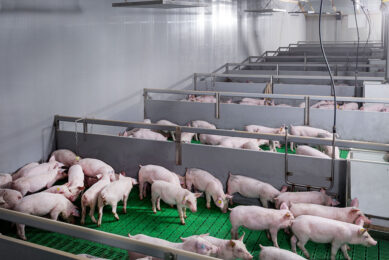Alphabet soup – the changing nomenclature and units in swine nutrition

As science evolves, insights and definitions in animal nutrition also continue to change, writes swine nutrition and health expert Dr Casey Bradley. But no matter how much the definitions change, one thing should never be forgotten, she adds: what are the practical implications of all that for the animal?
Navigating the evolving landscape of animal nutrition requires an in-depth understanding of changing nomenclature and measurement units. This is particularly evident in swine nutrition, where terms and calculations differ, not just across species, but also within nutrient categories.
A notable shift in swine nutrition is the gradual transition from metabolisable energy (ME) to net energy (NE). Each term, though representing similar concepts, is based on unique calculations, making it a challenge in a multi-species formulation system that juggles various versions of ME and NE.
Interpretation of lab results
This complexity extends to the interpretation of laboratory results, which often differ from the practical, as-fed basis used in swine diets. Understanding these nuances goes beyond mere conversions from mg/kg to ppm; it involves comprehending how these values affect the nutritional profile and health of the animal.
Different forms of butyric acid impact various parts of the digestive tract, demonstrating the importance of considering both the quantity and the functionality of ingredients
Today’s swine industry is revisiting the concept of acid-binding capacity (ABC), specifically ABC-4, which measures the acid required to bring the pH of a feedstuff down to 4. This shift is not to be confused with metrics like DCAD (Dietary Cation-Anion Difference) in dairy or dEB (Dietary Electrolyte Balance) in poultry. It highlights the importance of mineral content and ingredient forms in nutritional calculations. This focus on ABC-4 underscores our industry’s commitment to a more detailed level of nutrient balance, beyond just the macro level.
Butyrate or butyric acid products
Building on this theme of deeper nutritional understanding, let’s consider the use of butyrate or butyric acid products. These compounds illustrate that achieving nutritional goals is not just about hitting a target number in a formulation. Different forms of butyric acid impact various parts of the digestive tract, demonstrating the importance of considering both the quantity and the functionality of ingredients. Such an approach helps optimise the diet for the animal’s health and genetic potential, transcending traditional spreadsheet-based formulation.
Our industry often engages in debates over the most appropriate calculation methods, whether using the NRC or Brazilian tables. However, this focus on equations should not overshadow the primary goal: understanding the practical implications of these nutrients for the animal’s well-being.
Refining our understanding of protein and lysine
As we refine our understanding of protein and lysine in feedstuffs, it’s equally crucial to expand our evaluation to all nutrient components, moving from macro-level to micro-level nutrient interactions. This comprehensive approach allows us to consider the holistic impact of each nutrient, aligning with our broader objective of improving animal health and performance.
In conclusion, the evolving nature of swine nutrition demands a mastery of both the theoretical and practical aspects of these changes. As we innovate and adapt, our focus must remain on the implications of these changes for the animal, ensuring that our efforts in the field are always aligned with my motto of faithfully serving through science plus heart.
 Beheer
Beheer








 WP Admin
WP Admin  Bewerk bericht
Bewerk bericht